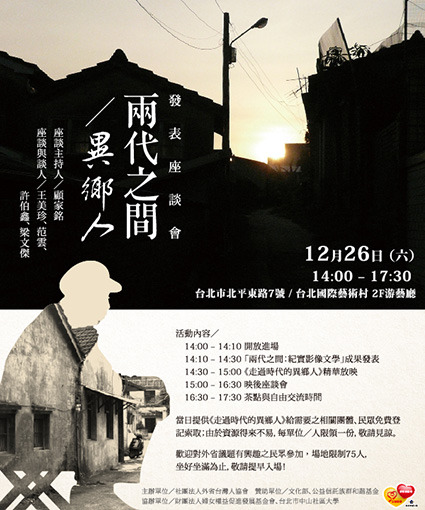Epilogue of my dissertation─廖凱弘的傳播教室─智邦公益電子報
enews.url.com.tw · April 30,2017Epilogue of my dissertation
This research was conducted by following the methodology of social constructionism and the qualitative approach, and using the in-depth interviews as well as focus groups interviews to collect the firsthand data. Thus, the researcher’s task was to make evident what these interviewees have coordinated and interacted with each other through the process of the research in order to represent the imaginative capacities of professional writers.
As a qualitative researcher, I was confident that I have succeeded in conducting the process of this inquiry, because I chose renowned professional writers and experts from industries and universities, both of whom have displayed the representative selections and thus contributed to thoughtful insights on the issue of imaginative capacity. Let us not forget that viewpoints from experienced participants are more important than anything else in the qualitative research. Furthermore, I used the set of indicators of imaginative capacity for assessing the case participants in the qualitative studies, for it has been verified reliably and validly in several quantitative studies. Consequently, this research tool could lead the whole interviews towards much broader exploration but more focused results and final synthesis. This dissertation has found additional support for existentialist Jean Paul Sartre’s thoughts that imagination itself is “a synthesis, not an element of consciousness”; and imagination itself is “an act, not a thing” (Sartre, 1936, 2012). That is to say, imagination must be viewed as a kind of the human capacity, forming a distinct synthesized structure that drives human to take action. The dissimilarity between the Sartre’s original work and this dissertation is that Sartre used the phenomenological approach to analyze the distinct existence of the human imagination; whereas I utilized the set of indicators to assess, analyze, and affirm the professional writers’ imaginative capacity through the methodology of social constructionism.
Furthermore, I extract the potential roots that might be beneficial to writer imagination when people or social organizations used certain cultivation methods/strategies to improve professionals’ imaginative capacity. Consequently, all the findings in this dissertation contribute to the “Green Lungs Model” for depicting the synthesis of the development of the imaginative capacity, which can also second again what Sartre stated that every psychic fact is a form, possessing a structure, and thus can be synthesized to construct a complete whole (Sartre, 1936, 2012).
What I have done hereby is to conduct a series of qualitative interviews, attempting to construct this holistic picture of the development of imaginative capacity for all professional writers. I expect that the “Green Lungs Model” could be applied to other professional fields and even the whole society, owing that we face a great amount of uncertainty and a large number of risks these days. Most leaders from those advanced countries ponder over those big problems we face and attempt to find out the solution to them together. However, the uncertainty and risks from outer environments seem to be larger than we can tackle at once. This is why the leaders from 147 nations have addressed the meeting, known as the Paris climate conference (COP21) in France on 7-8 December, 2015, and after that, up to 195 nations signed and adopted the Paris Agreement to set out a global action plan to put the world on track to avoid dangerous climate change by limiting global warming to well below 2°C (European Commission, 2015). However, it has been 18 years since the Kyoto Protocol was adopted in 1997, and 6 years since the Copenhagen Accord was adopted in 2009. The issue of climate change is still seriously concerned, and seems more difficult than ever to tackle it completely.
This event yields the following questions: Why do human beings appear incompetent when facing this kind of big uncertainty or risks? Do we possess weaker and weaker imaginative capacities to face those unforeseen uncertainty? Or are we losing more and more motivations to apply, track, or enhance our imaginative capacities to solve these problems that threaten ourselves and future generations more seriously? I think that the answers are no. The answers are exactly wrong if we give both the positive replies. So why have we seemed to be powerless to face the uncertainty, incapable of tackling those risks more immediately and efficiently?
I think that the point here is whether we dare take bolder actions with the utilization of our own imaginative capacities counts heavily. We can ask the following questions to ourselves: whether dare we transform knowledge from prior experiences or across multiple fields into the current solutions? Whether dare we probe the extensive unforeseen circumstances, and concretize the execution plans? Whether dare we debate on many possible confrontations, and reflect on man-made crucial problems focally? Whether dare we empathize with those unprivileged and expelled, and grasp insights about major risks people have or haven’t encountered quickly? Whether dare we generate unique perspectives freely to fight against those worse climate changes, and interpret the uncertainty we are threatened from diverse standpoints? And, ultimately whether dare we determine to achieve the goal to make our living environment sound and sustainable? I think if we can make every endeavor on each question aforementioned, we will make progress in resolving those difficult problems of our time.
All in all, in this dissertation, I have strived to provide a holistic picture of how human imaginative capacities can be developed for those who have the courage to take actions on the critical challenges humankind as a whole confronts nowadays. Of course, the contribution is made by all the participants concerned. Only for their selfless dedication can the researcher and future readers of this dissertation share the common insights and ideas of professionals’ imaginative capacity. As a qualitative researcher, all I could do is to reproduce and represent the socially-constructed findings as authentically as possible, analyzing and synthesizing the imaginative capacity of professional writers on the basis of all the participants’ intersubjectivity.
Therefore, the existence of the imaginative capacity can be affirmed, further traced, and even more nurtured for the purpose of maintenance, empowerment and enhancement of this kind of human nature, thus providing a positive contribution to the world.













